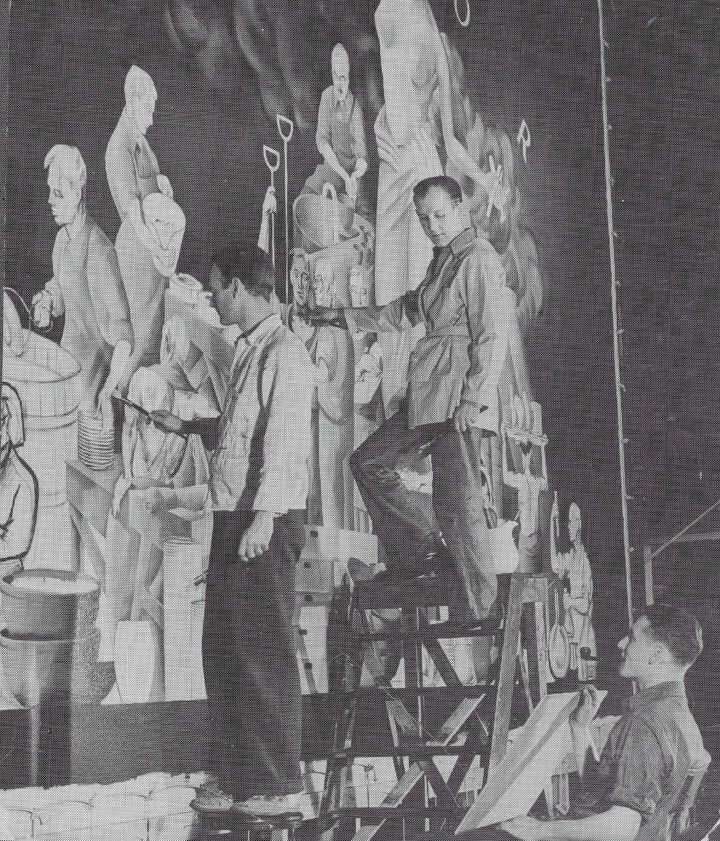|
In 1939 and 1940, the Homer Laughlin China Company participated in the New York World's Fair. The "American Potters" exhibit, complete with a working kiln, was located in the Home Furnishings Building. The objective was to demonstrate to the public the three main ways pottery is made: casting, jiggering, and throwing. The exhibit committee was headed by Arthur A. Wells of Homer Laughlin and managed in New York by John. E. Dowsing.
The following article on the exhibit ran in the August 1939 issue of Ceramic Industry:
Marking an event in the history of industrial relations, the American Potter exhibit is fascinating thousands of people every day with the handicraft and machine processing of American dinnerware. This exhibit represents the good will existing in the pottery industry between capital and labor and it was with aid of a contribution of $30,000 taken from the "strike fund" of the National Brotherhood of Operative Potters that the exhibit has grown to the prominence that it holds in the Home Furnishings Building. It has been said that The American Potter is regarded as the sixth most popular industrial exhibit on the Fair grounds.
The richly colored mural which overshadows the operating pottery, focal point in the exhibit, holds the story of the splendid relationship of 40 years in the collective bargaining between the union and the United States Potters Association. The mural (40 ft. long and 14 ft. wide, designed and executed by Charles E. Murphy of East Liverpool) is dominated by two 12 ft. figures: one representing Labor, interpreted by a group of life size workers busy at various pottery processes. Among these workers are the likenesses of A. V. Bleininger and Frederick Rhead. In this group of Labor there is also represented the likeness of James M. Duffy, president of the Brotherhood and this figure ties into the composition at the base of the other 12ft. figure representing Capital. Among the group in Capital there is the likeness of W. E. Wells, who was a power in developing the harmonious relations between capital and labor.
Manufacturer sponsers of The American Potter exhibit include: Cronin China Co., Hall China Co., Edwin M. Knowles China Co., Homer Laughlin China Co., and Paden City Pottery Co.
The entire exhibit coveres 2,300 sq. ft. and is composed of two separate sections. The one section contais five large displays of booths: one given exclusively to products of the five sponsors.
Directly across from this section is an operating pottery plant complete with all equipment. A counter 58 ft. long and 30 in. wide divides the plant from the product exhibit section. In this counter there are 20 spaces for dispaly of raw materials and accesories used in the manufacture of potteryware. The firms displaying here include: Youngstown Arc Engraving Co., Corckery & Glass Journal, and Commerical Decal Products Co.
Each pottery made special souveniers for the Fair with Homer Laughlin taking the lead. Knowles produced a marmalade, service plate, 14" urn (for display only), and a small coaster, Cronin a cake set, Paden City a salad bowl, and Hall China a special teapot.
Homer Laughlin made the following pieces, most of which were formed and glazed at the Fair. Service plates were made at the factory in Newell and shipped to the Fair as needed.
- 1939 and 1940:
- George Washington mug
- Small George Washington mug
- Thrower at the Wheel plate
- Artist at the Wheel plate
- Assorted sizes of vases
- Dated service plate
- 1940 only:
- Martha Washington mug
- Small Martha Washington mug
- Zodiac cup and saucer
- Spring ashtray
- Summer ashtray
- Autumn ashtray
- Winter ashtray
The mugs were supposed to be made in old ivory only, however some other colors such as yellow and dark blue exist. The thrower and artist at the wheel plates were made at the Fair using a hand jigger. They were glazed in turquoise and a tan, both of which are very easy to find today. Some were made in old ivory and light green. Other colors are very rare.
Zodiac cups and saucers are almost always found in turquoise. They were also made in old ivory and light green, but are much more difficult to find. The four seasons ashtrays were meant to be offered in standard glazes: turquoise for summer, red for autumn, old ivory for winter, and light green for spring. Collectors have been able to find each one in different colors.
Of all of the souvenirs, the George Washington mugs, potters' plates, and service plates were the best sellers.
Other firms not part of the American Potter exhibit made souvenir peices for the Fair such as Porcelier and Lenox among others.

The picture above shows Charles Murphy (center) paiting the 40-foot long mural for the Fair. At the time this was painted, Murphy was working as an artist at Commercial Decal Company in East Liverpool, Ohio. He had previously worked at Salem China and Homer Laughlin. To the left is William H. Blair, an artist originally from Mt. Vernon, Ohio. Seated on the right and holding a mock up of the mural as a guide is William Gill.
The murual was painted at Homer Laughlin's plant number 6 in Newell, WV. Once it was completed, area resedents could come to the pottery to view it. According to The Evening Review, the last such viewing was April 4, 1939 from 7 to 10 PM. The next day it was rolled up and shipped to New York for the Fair.
|